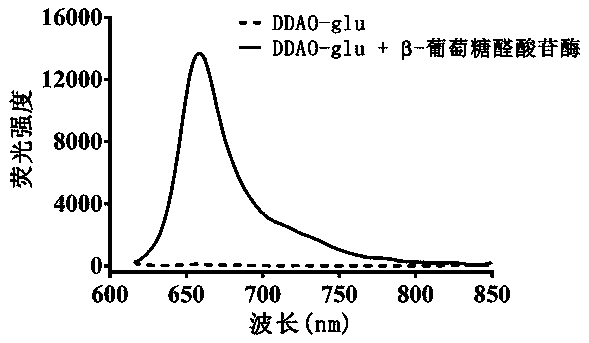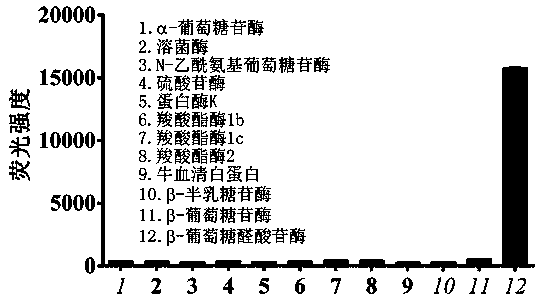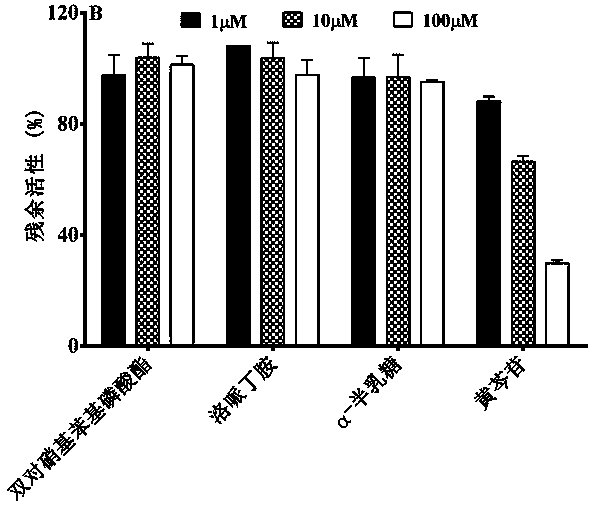Fluorescence probe based on beta-glucuronidase of acridone and application of fluorescence probe
A technology of glucuronidase and aldolase, which is applied in the field of fluorescent probes of beta-glucuronidase, can solve the problems of excitation, short wavelength, background fluorescence interference, etc., achieves high sensitivity, and has a simple and easy synthesis process. line, the effect of reduced interference
- Summary
- Abstract
- Description
- Claims
- Application Information
AI Technical Summary
Problems solved by technology
Method used
Image
Examples
Embodiment 1
[0026] Example 1. In vitro determination of the selectivity of different hydrolases
[0027] (1) Prepare 99 µL in vitro metabolic reaction system in advance, including pH 6.0 phosphate buffer (50 mM), different kinds of hydrolases (0.1 mg / mL), and pre-incubate at 37°C for 3 minutes with shaking;
[0028] (2) Add 1 µL of DDAO-glu at a concentration of 1 mM (final concentration 10 μM) to the reaction system to initiate the reaction;
[0029] (3) After 60 minutes, add 50 µL of glacial acetonitrile and shake vigorously to terminate the reaction;
[0030](4) After high-speed centrifugation at 4°C and 20,000×g for 20 minutes in a high-speed refrigerated centrifuge, the supernatant was collected for fluorescence detection (DDAO-glu: Ex=600 nm, Em=660 nm). The results show that only β -Glucuronidase (GLU) catalyzes the reaction, and the reaction rate is much higher than other hydrolases, indicating that β -The reaction of glucuronidase catalyzed DDAO-glu has good selectivity, and t...
Embodiment 2
[0031] Example 2. In vitro β -Inhibition experiment of glucuronidase
[0032] (1) Prepare 99 µL in vitro metabolic reaction system in advance, including pH 6.0 phosphate buffer (50 mM), β -Glucuronidase (0.1 mg / mL), and different concentrations of inhibitors (final concentrations were 50, 200, 600 μM) were pre-incubated with shaking at 37°C for 3 minutes;
[0033] (2) Add 1 µL of DDAO-glu at a concentration of 1 mM (final concentration 10 μM) to the reaction system to initiate the reaction;
[0034] (3) After 60 minutes, add 50 µL of glacial acetonitrile and shake vigorously to terminate the reaction;
[0035] (4) After high-speed centrifugation at 4°C and 20,000×g for 20 minutes in a high-speed refrigerated centrifuge, the supernatant was collected for fluorescence detection (DDAO-glu: Ex=600 nm, Em=660 nm). The results showed that only baicalin showed a dose-dependent inhibition of β - Catalyzed reaction by glucuronidase (GLU), while neither BNPP nor LAP (carboxyesterase...
Embodiment 3
[0036] Example 3 Different sources β - Activity assay of glucuronidase
[0037] (1) Prepare 99 µL in vitro metabolic reaction system in advance, including pH 6.0 phosphate buffer (50 mM), different sources β -Glucuronidase (0.1 mg / mL), pre-incubated with shaking for 3 minutes at 37°C;
[0038] (2) Add 1 µL of DDAO-glu at a concentration of 1 mM (final concentration 10 μM) to the reaction system to initiate the reaction;
[0039] (3) After 60 minutes, add 50 µL of glacial acetonitrile and shake vigorously to terminate the reaction;
[0040] (4) After high-speed centrifugation at 4°C and 20,000×g for 20 minutes in a high-speed refrigerated centrifuge, the supernatant was collected for fluorescence detection (DDAO-glu: Ex=600 nm, Em=660 nm). The results showed that different sources β -Glucuronidase, including recombinant expression single enzyme and subtype E. coli origin such as E.coli, E.coli IX and E.coli VII-A β -Glucuronidase can catalyze both HC-glu and DDAO-glu react...
PUM
 Login to View More
Login to View More Abstract
Description
Claims
Application Information
 Login to View More
Login to View More - R&D
- Intellectual Property
- Life Sciences
- Materials
- Tech Scout
- Unparalleled Data Quality
- Higher Quality Content
- 60% Fewer Hallucinations
Browse by: Latest US Patents, China's latest patents, Technical Efficacy Thesaurus, Application Domain, Technology Topic, Popular Technical Reports.
© 2025 PatSnap. All rights reserved.Legal|Privacy policy|Modern Slavery Act Transparency Statement|Sitemap|About US| Contact US: help@patsnap.com



